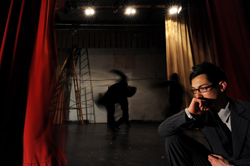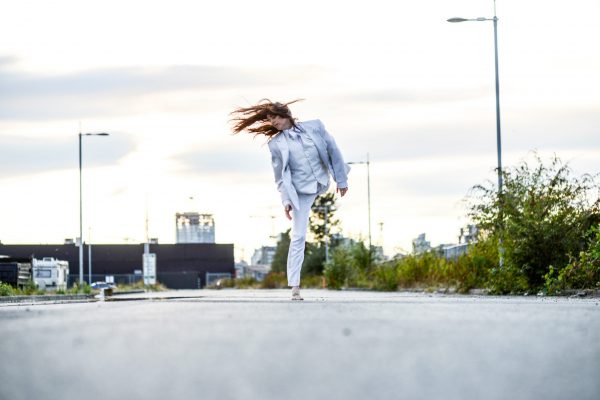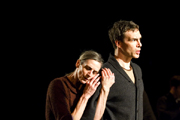Over the last few years, we’ve seen David Raymond and Tiffany Tregarthen, the duo behind Out Innerspace, dancing on Vancouver stages in works by local choreographers (they’re currently with Wen Wei Dance), and we’ve glimpsed them in their own short pieces. A charismatic couple, both are from small BC towns, and they have a lovely down-to-earth quality on stage, despite the big-city glamour of their typically cool contemporary movement. By contemporary I mean that mix of physical eruptions and tense poses that comes from hip hop, along with the long legs and smooth grace of ballet training, and with more, or less, taken on board from any other source imaginable. Here, in Raymond and Tregarthen’s first full-length work, “Vessel”, this contemporary aesthetic includes quirky moves and gestures performed with the deadpan seriousness familiar from modern dance, as well as a major interdisciplinary component.
“Vessel”, which premiered at the Roundhouse, features video projections of water, sometimes actual waves, but mostly inky black splashes that ooze over the white floor and backdrop. That backdrop isn’t much higher than the tallest dancer, creating a confined, intense space. During the long opening, given the amoeba-like way the five dancers clump together and then move apart, close to the floor, it was as if my eye was screwed to a microscope, watching the inexplicable action of microbial life in a Petri dish.
Only, if I were a scientist, I would definitely have called for more light. The video projections, designed by Raymond, are wonderfully atmospheric but need darkness to work. However, when they’re not being used, James Proudfoot’s lighting design, which saturates the stage in gorgeous colour — blue or yellow or purple — is not bright enough ; for the entire sixty-five minutes it’s as if the fog that shrouded the theatre as we entered has barely lifted.
The darkness almost sinks this boat because it means the dancers — Raymond and Tregarthen, along with Karissa Barry, Alison Denham and Tanner Plecas — are not fully visible. The movement itself adds to the evasiveness of the piece: the dancers crouch low to the floor, or huddle together, so we don’t see faces; in one fairly bright section, the dancers’ heads are tucked down toward their chests.
The strength of the lovingly designed choreography is its subtlety: Raymond and Tregarthen seem to be aiming for a radical level of intimacy. There are times, especially in their duet, when it’s like they are alone together, with no projection of energy beyond the bubble of their movement. There’s a determination not to play to the audience, obvious when the three women stand and face the audience, not doing much more than gazing keenly off into the distance, each eye line forging its own path, none of them toward us. The warm, naturalistic moments are fleeting, overwhelmed by the impersonal, robotic interaction that is the norm in “Vessel”: the dancers often come together stiffly, as if programmed to connect. These mechanical connections became wearisome, a mere device to get dancers together, or on and off stage.
While some of the quirky movement just seems clunky (like when Denham enters and exits on her hands and feet as if she’s collapsed from a backbend — an inefficient mode of travel), there is also evidence of serious choreographic exploration. Take the focus on the elbows for example. One motif has the elbow leading: it’s lifted high in front, the side of the hand lightly falling at the centre of the chest. The shape is odd but touching — the awkwardness of the arm, the focus on the chest near the heart and lungs, parts of our body we can’t see but on which we are so dependent.
In Raymond and Tregarthen’s duet, her long, leggy body whips around and over his compact, sturdier physique thanks to his graceful partnering. Plecas, an emerging dancer, has a solo with one cartwheel that flows from hand to hand with impossibly drawn-out musicality. The ensemble’s floorwork of rolls and upended shapes that leave them with backs to the audience is tightly performed, and their handwork is precisely timed as they sit cross-legged, tapping the floor and their knees in a simple repetitive sequence. In more imaginative gestural work, Tregarthen presses her open palms to the sides of her head like a headache is coming on, or as if she’s a model being directed to look sexy.
Jeff Younger’s splendid sound design is closely aligned with the work’s aesthetic of intimacy and elusiveness, of natural and mechanical. It begins with ocean waves, and then a gentle clicking is heard, maybe a neutral electronic noise or maybe a tongue hitting the roof of the mouth. During much of the piece, Younger balances ocean sounds with burbles and twangs that seem both electronic and organic at the same time. He also adds some compelling percussion that helps drive the dance more energetically. Heather Martin, a clothing designer whose company, mono, is based in Vancouver, costumed the dancers in a motley of soft, perhaps organic cotton pants, skirts and tops. These pale outfits look super comfortable, and fashionable in a relaxed, west coast way, but are not particularly interesting theatrically.
What Raymond and Tregarthen were driving at in “Vessel” remains as mysterious as the title itself, which could refer to a ship or a container or, in a poetic sense, to a person: but if a person, then what are they a vessel of? Still, their own focus and integrity in performance is immensely appealing. And there are moments — a few quiet, elusive gems — of richly choreographed thought.
Tagged: Contemporary, Performance, BC





